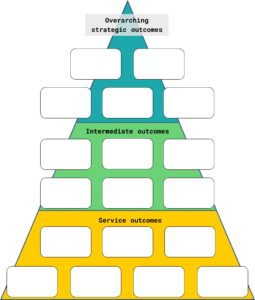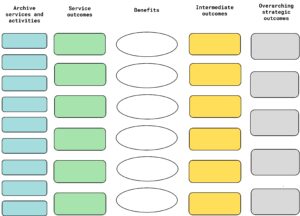Main section
Tabs Navigation
Tabs
Overview
The following examples suggest ideas to help you create an archives outcomes framework for health and wellbeing. You don’t need to be constrained by them; you can refer to the examples as much or as little as you want and adapt the framework.
Within your framework you may wish to illustrate how archives:
- Contribute to the requirements of the Public Health Outcomes Framework, which sets out the desired outcomes for public health. These outcomes reflect not only how long we live, our life expectancy, but on how well we live, with a focus on reducing differences between people and communities from different backgrounds.
- Support the joint strategic needs assessment. Upper tier and unitary authorities in England have a responsibility to improve the health of the population and are required to produce a joint strategic needs assessment (JSNA) of the health and wellbeing of their local community.
- In Scotland you might wish to align outcomes with the joint health improvement plans (JHIPs) for your local authority area.
- In Northern Ireland Local Commissioning Groups (LCGs) have responsibility for the health and social care, so refer to the findings of locally assessed needs.
- In Wales Local Health Boards carry out a well-being assessment and publish an annual local well-being plan.
Ideally your outcomes framework will consist of four elements:
- Outcomes triangle
- Logic model
- Evidence
- Performance indicators
Outcomes triangle and logic model
Outcomes triangle
The outcomes triangle gives an overview of how archives can contribute at service, intermediate and overarching strategic outcome levels.

The outcomes triangle model
Outcomes could be:
Overarching strategic outcomes
- Improved mental wellbeing and greater social connectedness
- Reduction in health inequalities
- Increased personalisation, choice and control
- Older people more socially and mentally active
Intermediate outcomes
- More people exercising choice, managing their own wellbeing and care
- Reduction in people with mental ill-health and increased personal resilience
- More older people playing a full part in their local community as active citizens
- More people participating in learning, work or other mentally stimulating activities
Service outcomes
- Increased engagement by young people and adults with long term health conditions
- More people gaining new knowledge, skills and education through archives
- More people volunteering and involved in community life through archives
- New offerings developed working in partnership with health and wellbeing services/organisations
Logic model
The logic model illustrates the main links between service activities and local outcomes. This example suggest broad groupings of activities, benefits archives can offer to individuals, communities and places, and how these in turn contribute to the achievement of intermediate and overarching strategic outcomes.

A logic model template
Outcomes might be:
Archive activities
- Volunteering opportunities
- Training, employment and mentoring schemes
- Hosting targeted and special interest groups
- Knowledge and learning/skills courses and programmes
- Support for research activity
- Facilities and information provision
- Development and outreach work
- Events, sessions and clubs
Service outcomes
- More people volunteering and involved in community life through archives
- New offerings developed working in partnership with health and wellbeing services/organisations
- More people gaining new knowledge, skills and education through archives
- Increased engagement by young people and adults with long-term health conditions
Benefits
- Increased social interaction and new relationships
- Improved sense of well-being
- Increased knowledge, skills and qualifications
- Increased confidence, self-esteem, personal responsibility and resilience
Intermediate outcomes
- Reduction in people with mental ill-health, and increased personal resilience
- More older people playing a full part in their local community as active citizens
- More people participating in learning, work or other mentally stimulating activities
- More people exercising choice, managing their own wellbeing and care
Overarching strategic outcomes
- Improved mental wellbeing and greater social connectedness
- Older people becoming more socially and mentally active
- Reduction in health inequalities
- Increased personalisation, choice and control
Our section on ‘What to include‘ has more information about the outcomes triangle and logic model methods
Step two of ‘Creating your framework‘ features a step by step guide to creating an outcomes triangle and logic model
Evidence
The evidence section of the framework underpins the outcomes triangle and logic model. It lists the sources of evidence that together best demonstrate the contribution of archives to the outcomes.
We have identified some examples of validated national evidence that demonstrate the contribution of archives to outcomes for health and well-being. You may have other examples relevant to your local outcomes.
Stage three of ‘Creating your framework‘ contains a step-by-step guide to reviewing the evidence
‘Advancing the Role of Museums in Health and Social Care’ (National Museums Liverpool, 2022)
This paper reflects on the development and impact of House of Memories as a flagship cultural intervention in dementia care built around the museum objects and social history collections within National Museums Liverpool. The approach aimed to support people living with dementia, enhancing their wellbeing and quality of life, as a potential alternative to medication.
‘Creatively Minded and Heritage’ (The Baring Foundation, 2021)
Report commissioned to showcase how heritage brings significant added value in cross-sectoral social prescribing programmes, to improve people’s mental health and community connections. Case studies include natural and historic environments, archaeology and seven archive examples.
‘Heritage and Wellbeing’ (What Works Wellbeing, 2019)
A scoping review of evidence which found that historic places and assets, and interventions associated with them, can have a wide range of beneficial impacts on the physical, mental and social wellbeing of individuals and communities.
‘Cultural engagement and incident depression in older adults’ (The British Journal of Psychiatry, Vol. 214, Iss. 4, 2019)
A paper that explores whether cultural attendance such as visits to the theatre, concerts or opera, the cinema, art galleries, exhibitions or museums by older adults is associated with a reduced risk of developing depression. It concludes that cultural engagement appears to be an independent risk reducing factor for the development of depression in older age.
‘The impact of volunteering in archives‘ (Archives and Records Association, 2018)
Research highlighting the impacts of volunteering in archives and how these affect volunteers, services, and the profession. Volunteers feel the long-term effects of improved health and well-being, new and re-enforced skills and enhanced prospects of employability.
Performance indicators
Below are suggestions of how to measure the contribution of archives to better outcomes across a number of policy themes. Not all of these suggestions will be relevant to your local outcomes.
You should select a small number of indicators from across the different levels that together best measure the contribution of archives to your service, intermediate and overarching strategic outcomes. Draw on available data from existing sources within your local council or organisation and elsewhere wherever possible.
Stage four of ‘Creating your framework’ has a step-by-step guide to selecting performance indicators
Overarching strategic outcomes
These are very high-level, long-term outcomes that archives, along with other services, contribute to across the local population. They are likely to reflect the overall responsibilities of key decision-makers; notably local government, but also other key stakeholder groups such as health and social care providers.
Examples include:
- Loneliness: percentage of adults who feel lonely often or always or some of the time
- Social Isolation: percentage of adult social care users who have as much social contact as they would like
- Self-reported wellbeing: satisfaction, happiness, anxiety and feel things are worthwhile
- Health related quality of life for older people
- Employment for those with a long-term health condition including those with a learning difficulty/disability or mental illness
Intermediate outcome indicators
These should include indicators that reflect the specific contribution of archives to the intermediate outcomes.
Examples include:
- people who agree that participation in an archive project, activity or event has made them more likely to lead a healthier lifestyle
- people who agree that participation in an archive project, activity or event has helped them increase their understanding of how to improve their health or exercise patient choice
- people who agree that participation in an archive project, activity or event has helped them manage their health condition
- people who agree that participation in an archive project, activity or event has improved their mental well-being or sense of identity
- people who agree that participation in an archive project, activity or event has helped them meet and connect with local people or made them feel part of their community
Service outcome indicators
These are indicators specific to archives.
Examples include:
- Percentage of:
- people who agree that participation in an archive project or event has been enjoyable
- young people, adults or older people volunteering in the archive
Where possible indicators should be broken down further, for example people at risk of or recovering from specific health conditions, people with a disability or limiting illness and other disadvantaged and or vulnerable groups.
Indicators can also be broken down to differentiate in-house, commissioned or external.
Service output indicators
These indicators are also specific to archives.
Examples include:
- Number of:
- young people and adults or older people participating in archive activities, project or events
- visits or participants in the archive offer (per 1,000 population)
- children and young people participating in archive activities during the school holidays
- young people, adults or older people regularly volunteering in the archive
- young people, adults or older people participating in or completing health-related archive activity programmes
- new partnerships/projects developed specifically to provide health and wellbeing outcomes
Where useful indicators can be broken down further, for example, by geographic area or target wards or by specific groups, including different age groups or disadvantaged and or vulnerable groups.